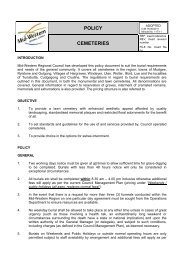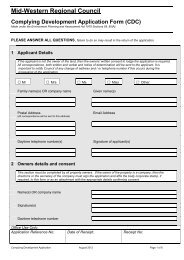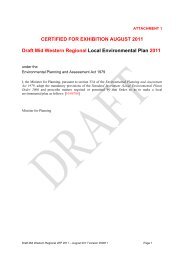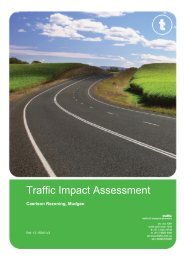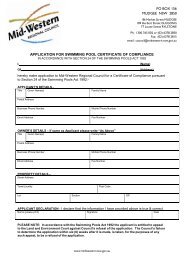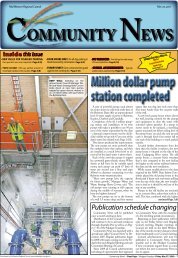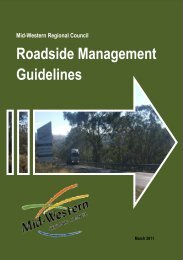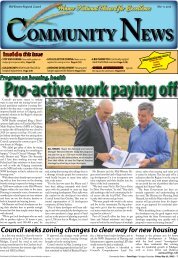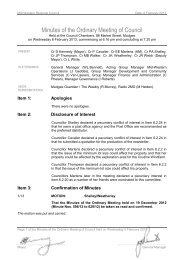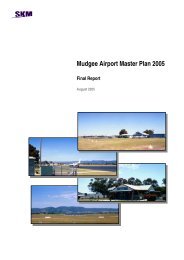preliminary soil salinity assessment - Mid Western Regional Council
preliminary soil salinity assessment - Mid Western Regional Council
preliminary soil salinity assessment - Mid Western Regional Council
You also want an ePaper? Increase the reach of your titles
YUMPU automatically turns print PDFs into web optimized ePapers that Google loves.
likely to have reduced the concentration of salts in the upper layers of <strong>soil</strong> across the site. The rateof leaching depends on a number of factors including the amount of water applied and how freelydraining <strong>soil</strong>s are through the profile and determining the long term movement of leached salts isbeyond the scope of this <strong>preliminary</strong> investigation.2.4 Site InspectionOn 8 th May 2012 Minespex carried out a brief site inspection for the purpose of planning for <strong>soil</strong>testing. Initial <strong>soil</strong> <strong>salinity</strong> testing on the northern side of Saleyards Lane was restricted by:Stockpiles of roadwork’s material being stored on this area of land creating areas that wereinaccessible to the excavator and <strong>soil</strong> sampler ;Activity of machinery on the site during <strong>soil</strong> testing associated with this roadwork material.The following week on 15 th May 2012 a field investigation was carried out onsite with visualobservations recorded including topography, existing vegetation type and density, and <strong>soil</strong>condition. At this time Minespex also carried out top and sub<strong>soil</strong> sampling to assist with an overall<strong>preliminary</strong> <strong>salinity</strong> <strong>assessment</strong> at four sites (Sites 1 to 4). The <strong>soil</strong> samples were forward to ALSLaboratory in Sydney for analysis to determine electrical conductivity (EC w 1:5 ), cation exchangecapacity (CEC), sodium (ESP % and sodium mg/kg), pH w , chlorides (meq/100g) and <strong>soil</strong> texture.Following receipt of these initial <strong>soil</strong> test results and improved access to the northern area of thesubject land with the council removing roadworks stockpiles and leveling the site, further top andsub<strong>soil</strong> testing was carried out at two sites (Sites 5 and 6) immediately adjacent to the truckwashdown facility and remaining leachate pond on 3 rd July 2012. The <strong>soil</strong> samples were to ALSLaboratory in Sydney for analysis of the same parameters as for Sites 1 to 4.2.5 Landscape Description and Site Observations of Salinity IndicatorsThere are a number of factors that have been considered to provide a <strong>preliminary</strong> <strong>assessment</strong> of the<strong>salinity</strong> hazard at the site such as regional <strong>salinity</strong> issues, topography, vegetation, site history, <strong>soil</strong>type, <strong>soil</strong> condition and surface water movement. This information has been used as part of theoverall <strong>salinity</strong> risk <strong>assessment</strong> and to determine a suitable <strong>soil</strong> sampling protocol for the site.The previous land use has impacted dramatically on vegetation across the site with the majority ofgroundcover consisting of species that are able to establish and survive in highly disturbed, poor<strong>soil</strong>s. In particular, couch grass (Cynodon dactylon) and slender rat’s tail grass (Sporobolus spp.) aredominant on the southern side of Saleyards Lane, with kikuyu (Pennisetum clandestinum) growingprolifically on the land north of the lane and other low lying areas across the subject land.Whilst both couch and kikuyu grasses are considered <strong>salinity</strong> indicator species, they are also knownto invade disturbed, poor <strong>soil</strong>s where <strong>salinity</strong> is not an issue and are found extensively within theMudgee region as lawn grasses.No bare patches, saline scalds or seepage areas were visible during the site inspection. Trees acrossthe site were in reasonable condition.The SES building had very little indication of possible <strong>salinity</strong> damage to the exterior. There were noobvious wet ‘tide’ marks on the building. White colouration was seen on three small spots on bricksPRELIMINARY SOIL SALINITY ASSESSMENT8



